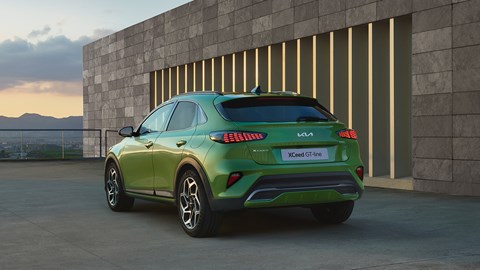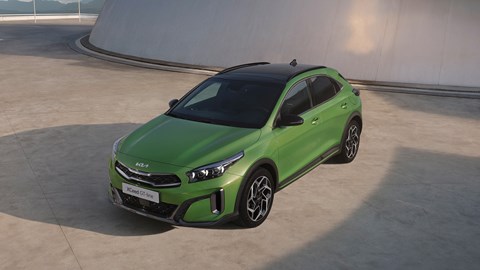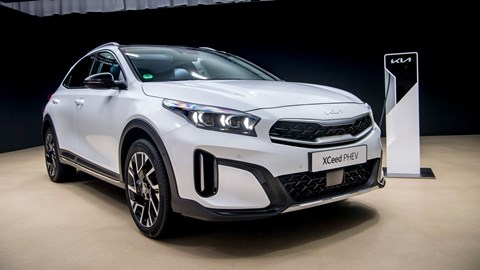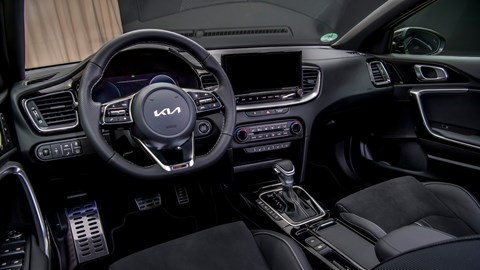► Facelift brings revised styling and new GT-Line S trim
► Choice of petrol and plug-in hybrid powertrains
► First deliveries set to arrive in late summer 2022
Kia has confirmed the facelifted XCeed crossover will be priced from £22,995 in the UK. The updated model features a range of exterior and interior enhancements designed to keep it competitive with the growing armada of family SUV rivals. So, this update is an important one.
Key competitors include the Toyota C-HR, Volkswagen T-Roc, MINI Countryman and Mazda CX-30. There are also several similarly sized, premium-badged SUVs such as the BMW X2, Mercedes GLA and Audi Q2 – and that’s before we mention lifted hatchbacks like the Ford Focus Active.

The XCeed is one of Kia’s main breadwinners. The SUV accounts for 10% of the brand’s total UK sales, with more than 5,600 examples sold in the first half of 2022 alone. It also makes up 51% of Kia’s UK Ceed sales, which means it’s more popular than the firm’s standard family hatchback.
Walk me through the line-up.
Certainly. You have a choice of three trim levels called 2, 3 and GT-Line S. The last one is a new addition to the range that was added as part of the facelift. More on that later, though.
The cheapest XCeed 2 comes as standard with 16-inch alloy wheels, LED headlights, cruise control and a reversing camera. Inside, you get black fabric upholstery, a leather steering wheel, a few USB sockets and an 8.0-inch infotainment system with Apple CarPlay and Android Auto.
Kia’s 3 grade is priced from £25,495 and builds on the base-model’s specification with 18-inch alloys, privacy glass, electrically folding door mirrors, rear parking sensors and keyless go. The cabin also gets a lift with part-leather upholstery, heated front seats, power lumbar support, dual-zone air conditioning and a larger 10.25-inch infotainment screen.

Kia’s flagship GT-Line S specification replaces the XCeed’s old 4 specification – but it has a slightly different brief. It’s being pitched as the sporty option in the SUV’s range, so it features a racy body kit, model-specific 18-inch alloy wheels, a panoramic sunroof and smart parking assist.
The cabin gets a lift, too, with leather and suede upholstery, heated outer rear seats, a wireless smartphone charger, an eight-speaker JBL stereo and a 12.3-inch digital gauge cluster. You also get a little more technology, such as an intelligent speed limit warning system and blind-spot monitoring. Prices for the range-topper start from £29,995.
What about the engines?
You have two options for the time being, although Kia will add a couple more once it’s sorted out the issues in its supply chain. For now, the entry-level engine is a turbocharged 1.5-litre four-cylinder unit with 158bhp and 187lb/ft of torque. It’s paired with a six-speed manual gearbox as standard, although you can have a seven-speed automatic as an optional extra.
Above that, there’s a plug-in hybrid option priced from £32,595. The system mixes a 1.6-litre petrol engine with an 8.9kWh battery pack and a 44.5kW electric motor for a combined output of 139bhp and 195lb/ft of torque. Kia also says the battery pack can store enough energy for an electric-only range of around 30 miles.
Eventually, buyers will also be offered a cheaper 1.0-litre three-cylinder petrol engine with 118bhp and 126lb/ft of torque. Kia will also reintroduce its 1.6-litre four-cylinder diesel unit to the XCeed range, which generates 134bhp and 207lb/ft. However, if you specify that engine with Kia’s optional seven-speed automatic gearbox, its torque figure jumps up to 236lb/ft.

Unlike the petrol units, the diesel engine features 48-volt mild-hybrid assistance and comes as standard with Kia’s Intelligent Manual Transmission. The electronically controlled gearbox is designed to improve efficiency, as it allows the car to coast with the engine off even when it’s in gear.
It can coast to a halt with the engine off and, when operating in Eco mode, it can coast at speeds of up to 77mph. The engine reactivates when the driver presses the throttle, brake or clutch. Kia says the technology helps reduce CO2 emissions by around three percent in real-world driving conditions.
European buyers can also the XCeed with the same 1.6-litre four-cylinder petrol engine as the Kia Ceed GT warm hatchback. It produces 201bhp and 195lb/ft of torque, which Kia says is enough for a 0–62mph time of 7.5 seconds. Sadly, we’re not getting this engine in Britain. We’re blaming it on Brexit.
It’s also worth giving the XCeed’s suspension a mention because it’s rather trick. Instead of fixed rubber bump stops, it features hydraulic rebound stoppers in the dampers. Kia says this change allows the suspension to progressively absorb massive bumps rather than hammering the dampers at the end of their travel and sending a jolt through the cabin.
So, what has Kia changed for the XCeed’s facelift?
The styling, for starters. The updated XCeed gets new LED headlights, reshaped front and rear bumpers, a new radiator grille and a fresh pair of taillights. Kia has also moved the fog lamps into the XCeed’s main headlamp unit, which has made space for a pair of drag-reducing air curtains on the front bumper. Apparently, that benefits the car’s fuel economy.
Changes to the XCeed’s cabin are a lot less noticeable. The more expensive versions get the same 12.3-inch digital gauge cluster and 10.25-inch infotainment system as the outgoing model, while analogue gauges and a smaller eight-inch infotainment screen are offered on entry-level cars.

Kia has changed up the XCeed’s interior, though, swapping the old model’s colourful trim and upholstery for monochrome replacements. It’s likely better for residuals. There’s a new black surround for the gear selector, a fresh sliver panel under the touchscreen and a range of new seat fabrics in cloth, suede, synthetic leather or real leather.
Any change to the XCeed’s practicality?
Not that we can see. Boot space remains the same at 426 litres with the rear seats in place and 1,378 litres with the rear bench stowed. The same 40:20:40 split-folding bench has been carried across the facelift and the amount of space inside for people hasn’t changed.
There’s also a handy adjustable boot floor which can be mounted in two positions. Kia says the lower setting allows taller items to be transported more easily while the higher setting makes it easier to lift heavy items into the boot. Also, when the boot board is in its higher setting, you get a hidden storage area underneath it.